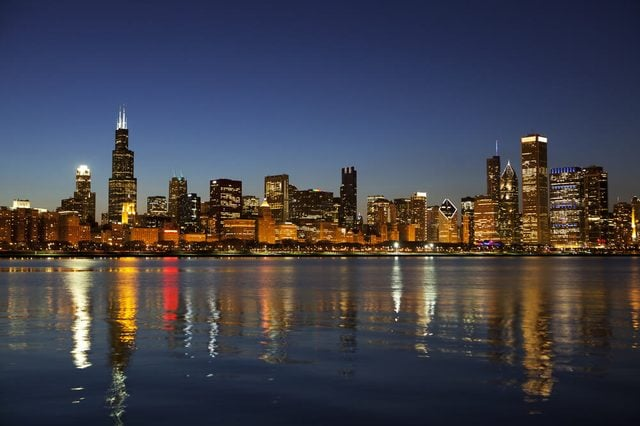Search This Blog
Wednesday, August 28, 2024
Tuesday, August 27, 2024
Why "Windy City?"
An excerpt from Readers' Digest -
The Surprising Reason Why Chicago Is Called the "Windy City"
It's got nothing to do with the weather.
By Meghan Jones
 |
| Grey Tree Studios/Shutterstock |
| Well, when the nickname came to be, the “Windy City” meaning wasn’t describing the weather but the people. (Don’t worry, not that kind of wind.) Nineteenth-century journalists first gave Chicago this designation when criticizing the city’s elite as “full of hot air.” In the Chicago Daily Tribune, a reporter wrote in 1858 that “[a] hundred militia officers, from corporal to commander … air their vanity … in this windy city.” Another reporter, a proud citizen of Milwaukee, boasted that his own city was the better of the two: “We are proud of Milwaukee because she is not overrun with a lazy police force as is Chicago—because her morals are better … than Chicago, the windy city of the West.” They meant that the city was full of “windbags,” people with inflated egos who cared about nothing but profit. (Learn these 12 signs someone has a massive ego.) https://www.rd.com/article/chicago-windy-city/ |
Monday, August 26, 2024
Saturday, August 24, 2024
Wednesday, August 21, 2024
Monday, August 19, 2024
21 Clever Memory Tools
An excerpt from Buzzfeed -
21 Clever Mnemonic Devices That Will Help You Remember Almost Everything
Please Excuse My Dear Aunt Sally.
By Sarah Aspler, BuzzFeed Staff, Canada
 |
| BuzzFeed / Getty |
4. The order of mathematical operations:
 |
| BuzzFeed / Getty |
5. When to use "affect" or "effect":
 |
| BuzzFeed / Getty |
A Freshman at Georgia Tech at 13
An excerpt from CBS Evening News -
He was reading at 1 and doing fractions by 2. At 13 years old, he's majoring in aerospace engineering at Georgia Tech.
By Mark Strassmann
The 360 Degree Revolving, Titling House
An excerpt from designboom -
alex schweder + ward shelley's 'ReActor' house rotates atop a concrete column
The Valley of the Dolls
An excerpt from AllThatsInteresting -
Haunting Photos Of Nagoro, The Japanese Village Where The Dead Are Replaced With Life-Size Dolls
Artist Tsukimi Ayano has made at least 400 dolls to repopulate the dwindling village of Nagoro
By Erin Kelly | Edited By Jaclyn Anglis
 |
| Several dolls sit lined on a bench. KAZUHIRO NOGI/AFP via Getty Images |
BACK-TO-SCHOOL
It’s BACK TO SCHOOL time in America. And if we don’t trust Trump with our kids, we can’t trust him with our country.
— Eric Swalwell (@ericswalwell) August 14, 2024
🎬WATCH my new ad pic.twitter.com/2qGmeWAPm7
Time Magazine's 2024 Kid of the Year
An excerpt from Time -
Facts About the US Black Population
An excerpt from Face2Face Africa -
8 facts about the U.S. Black population you should know
BY Kofi Oppong Kyekyeku
 |
| Facts about Black people in U.S. - Original photo credits: Pew Research Center and ABC News |
Population
The U.S. Black population in 2022 can be categorized into four distinct groups:
- The total U.S. Black population
- Single-race, non-Hispanic Black people
- Multiracial, non-Hispanic Black people
- Black Hispanic people
Daddies and Daughters
An excerpt from The Daily Beast -
Why Every Father Needs to Watch the Netflix Film ‘Daughters’
The new documentary is about a father-daughter dance at a prison. As one dad of two girls writes, it’s a must-see film that brings all of parenthood into perspective.
By Andrew Crump
Reams of data exist that highlight the range of effects a father’s absence can have on his daughters. They’re likely to struggle with trust issues. Their confidence might flag. They may wrestle with feelings of abandonment, low self-esteem, and rejection, or develop aggressive or otherwise antisocial behaviors, or risk-taking behaviors; they may become depressed, detached, or anxious. Fathers shape their daughters’ relational lives—the foundation and maintenance of meaningful relationships, with family, with friends, with romantic partners, with communities—and spur their creativity.
Angela Patton and Natalie Rae’s Daughters, the Festival Favorite and Audience Choice: U.S. Documentary Competition winner at this year’s Sundance Film Festival—now available to watch on Netflix—side steps statistical analysis and instead strives for emotional impact.
I have two daughters myself. For their privacy’s sake, I’ll refer to them by their nicknames: Brontosaurus, my eldest, and Elephant, my youngest. I love them more than anything I’ve loved in my forty years on this Earth.
On behalf of that, I intentionally avoided Daughters in my remote coverage of Sundance, knowing full well a movie with that title, focused on the subject of barriers forced between young girls and their incarcerated dads, would likely break me in two; the idea of being separated from my girls is the stuff of my nightmares, as unlikely as it is that we’ll ever be separated. (Sending them off to summer camp and, soon, back to school is hard enough.) I am not a statistic. Brownie and Elephant aren’t, either. All the same, my reality didn’t blunt Daughters’ effect on me.
This is not a film about the numbers: How many girls grow up fatherless in the U.S.; how many of those girls end up in bad partnerships; how many of them become teen mothers; how many are burdened by mental health problems; how many attempt suicide. Frankly, that wouldn’t be a film at all, had Patton and Rae chosen these details as their subject. It would be an academic paper instead, dry and sans any human sensation.
Sensation is what Daughters is all about, of course, a front row seat to an overwhelming reconnection between a cadre of girls and their fathers, each behind bars for reasons Patton and Rae refuse to detail. (Those reasons are neither our business nor relevant to the film’s thesis.). At the same time, it’s an elegant condemnation of America’s love affair with crime and punishment, exhibited through varied atrocities carried out within its prison system.
https://www.thedailybeast.com/obsessed/netflixs-daughters-the-movie-every-father-needs-to-watch

